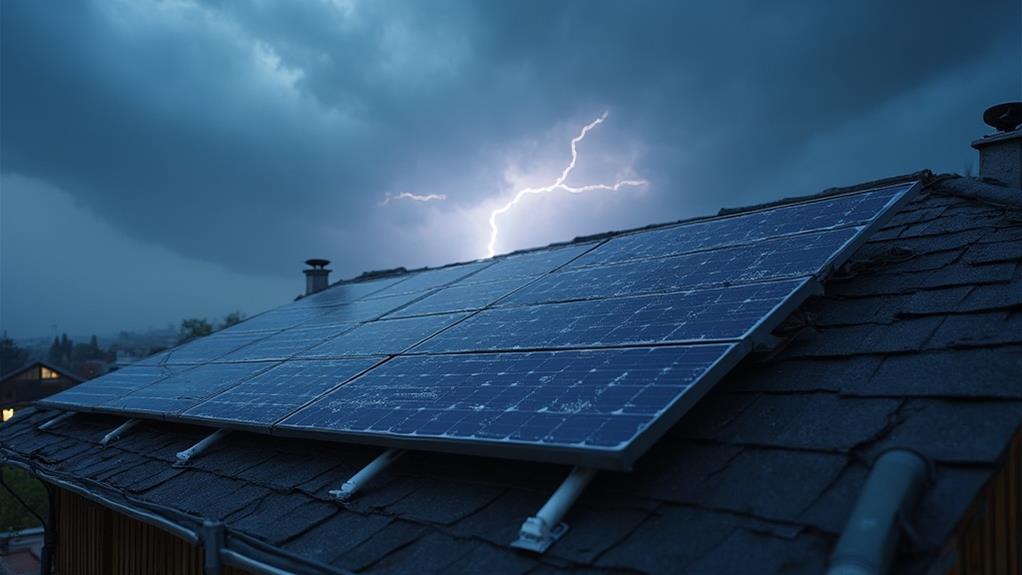Protecting solar panels from storm damage requires a multifaceted approach. Start by ensuring panels meet rigorous durability standards and are properly installed on a structurally sound roof. Implement weather monitoring systems to track potential threats and take preventive action. Regular maintenance and inspections can identify vulnerabilities before storms hit. Prepare for severe weather by securing loose components and clearing debris. Review insurance coverage to ensure adequate protection for your investment. After a storm, conduct thorough assessments to detect any damage. By following these steps, homeowners can safeguard their solar panels and maximize their long-term energy benefits. Discover more strategies to shield your sustainable energy system from nature's fury.
Understanding Storm Risks
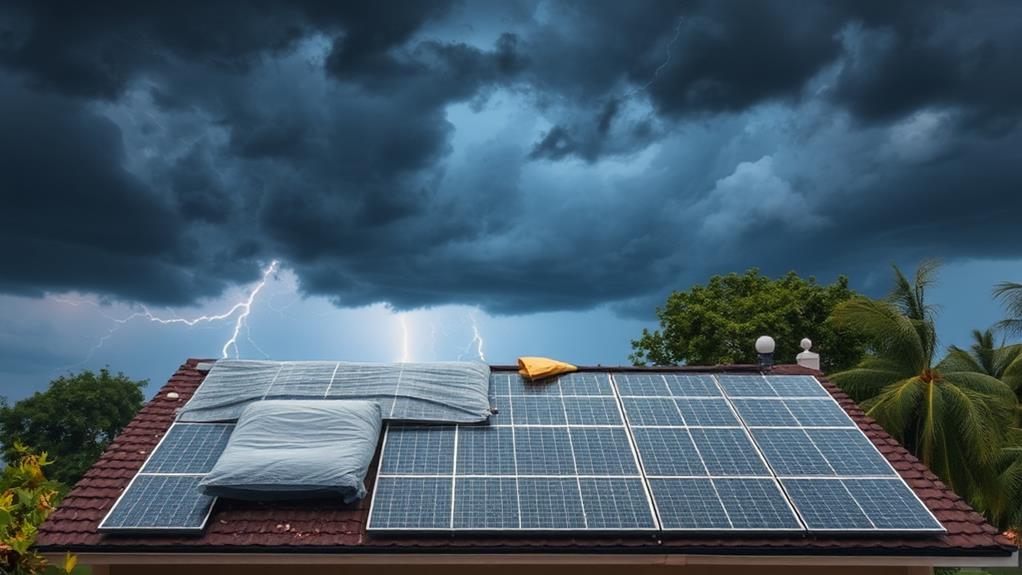
Storm clouds gathering on the horizon serve as a stark reminder of the potential risks faced by solar panel installations. While solar panels are designed to withstand various weather conditions, severe storms can pose significant threats to both the panels and the underlying roof structure. High winds, hail, lightning strikes, and flying debris are primary concerns during extreme weather events.
Wind damage is particularly problematic, as strong gusts can lift panels or loosen their attachments, potentially causing them to detach from the roof. Hailstorms present another risk, with large hailstones capable of cracking or shattering solar cells. Lightning strikes, though rare, can cause electrical surges that damage the panels' internal components or the inverter system.
Additionally, heavy rainfall and flooding may lead to water infiltration, compromising the roof's integrity and the panels' connections. Falling branches or other wind-borne debris can also impact panels directly, causing physical damage or obstructing sunlight absorption. Understanding these storm-related risks is crucial for homeowners and installers to implement appropriate protective measures and ensure the longevity of solar panel systems while safeguarding the roof structure beneath.
Solar Panel Durability Standards
Given the potential risks posed by severe weather, it's important to consider the durability standards that govern solar panel manufacturing and installation. Solar panels are designed to withstand various environmental challenges, including high winds, hail, and heavy snow loads.
The International Electrotechnical Commission (IEC) sets global standards for solar panel durability, with IEC 61215 being the primary certification for crystalline silicon modules. This certification requires panels to undergo rigorous testing, including thermal cycling, humidity freeze, and mechanical load tests. Additionally, many manufacturers conduct their own tests that exceed IEC standards. For instance, some panels are certified to withstand wind speeds up to 140 mph and hail impacts of up to 1 inch in diameter.
In the United States, the UL 1703 standard ensures that panels meet specific safety requirements. Furthermore, local building codes often dictate additional durability standards based on regional weather patterns. When selecting solar panels, consumers should look for products that meet or exceed these standards, particularly in areas prone to severe storms. Proper installation by certified professionals is equally crucial in ensuring the longevity and resilience of solar panel systems against extreme weather conditions.
Roof Integrity Evaluation
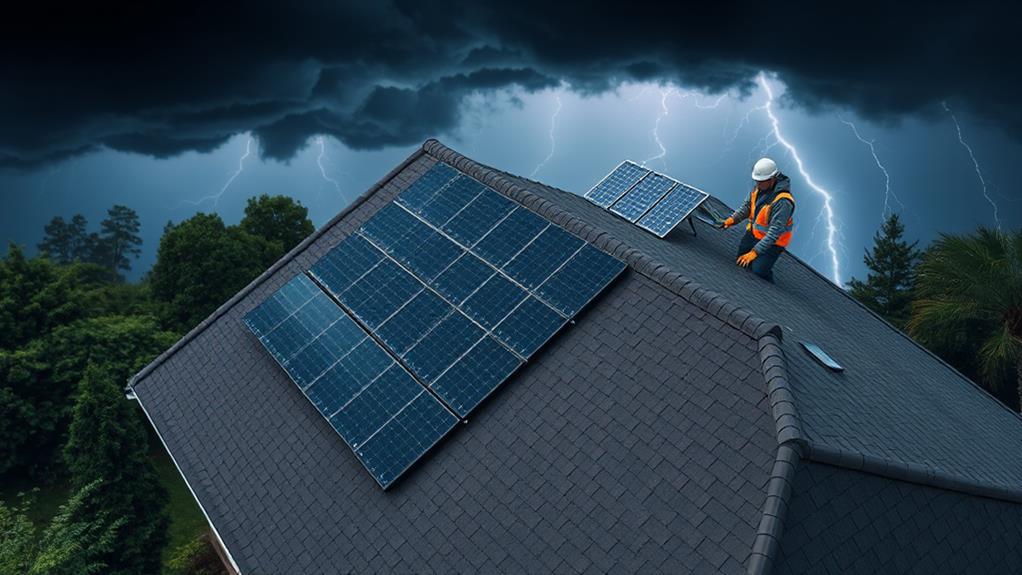
Before installing solar panels, a thorough evaluation of the roof's integrity is essential. This assessment ensures that the roof can support the additional weight of the solar system and withstand potential weather-related stresses. A professional inspector should examine the roof's structural components, including trusses, rafters, and decking, to determine if reinforcement is necessary.
The inspection should also check for existing damage, such as water leaks, cracked tiles, or deteriorating shingles. These issues must be addressed prior to solar panel installation to prevent future complications. The roof's age is another crucial factor; if it's nearing the end of its lifespan, replacement before solar panel installation may be advisable.
Slope and orientation of the roof should be evaluated to optimize solar panel placement and efficiency. Additionally, the inspection should assess the roof's ability to handle snow loads and high winds, particularly in areas prone to severe weather. Proper flashing and waterproofing techniques must be implemented to maintain the roof's integrity after panel installation. A comprehensive roof evaluation not only ensures the longevity of the solar system but also protects the homeowner's investment in both the panels and the property.
Proper Installation Techniques
Precision is paramount when it comes to proper installation techniques for solar panels. Professional installers should follow industry-standard practices to ensure the longevity and effectiveness of the system while maintaining roof integrity.
Key steps include accurately measuring and mapping the roof surface, selecting appropriate mounting hardware, and using proper sealing methods to prevent water infiltration.
Installers must carefully position panels to optimize sun exposure while adhering to local building codes and setback requirements. The mounting system should be securely anchored to the roof's structural supports, typically the rafters or trusses, rather than just the decking. This approach distributes the weight evenly and enhances the system's ability to withstand high winds.
Proper flashing techniques are crucial to maintain the roof's waterproof barrier. High-quality sealants and weatherproofing materials should be applied at all penetration points. Additionally, installers should ensure adequate spacing between panels and the roof surface to allow for proper ventilation and drainage. This helps prevent moisture buildup and potential damage to both the panels and the roof structure.
Regular inspections and maintenance checks are essential to identify and address any issues promptly.
Weather Monitoring Systems
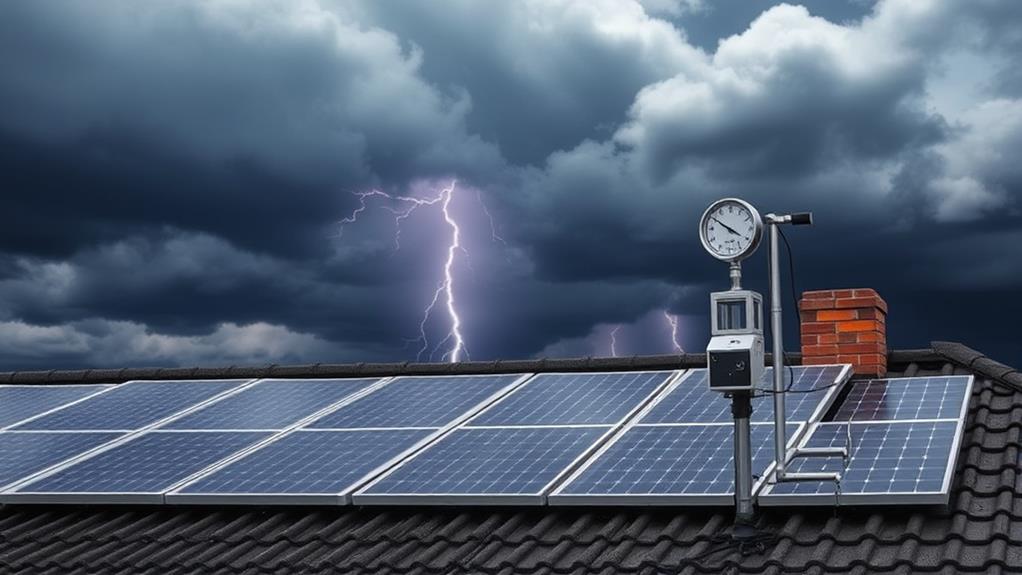
While solar panels are designed to withstand various weather conditions, incorporating a weather monitoring system can significantly enhance their protection and performance. These systems provide real-time data on local weather patterns, allowing homeowners and solar installers to take proactive measures to safeguard their investment.
Weather monitoring systems typically include sensors for wind speed, temperature, humidity, and precipitation. Advanced setups may also feature lightning detection and hail sensors. This comprehensive data helps predict potential risks to solar panels, such as high winds or severe storms. With this information, automated systems can adjust panel angles to minimize wind resistance or trigger protective measures like panel coverings.
Integration with smart home technology enables remote monitoring and control, allowing users to receive alerts and make adjustments from anywhere. Some systems even incorporate machine learning algorithms to improve prediction accuracy over time. By analyzing historical weather data alongside panel performance metrics, these systems can optimize energy production and maintenance schedules.
When selecting a weather monitoring system, consider factors such as sensor accuracy, data transmission reliability, and compatibility with existing solar equipment. Professional installation ensures proper calibration and seamless integration with your solar panel setup.
Regular Maintenance and Inspections
Building upon the benefits of weather monitoring systems, regular maintenance and inspections form the backbone of long-term solar panel protection. These proactive measures ensure optimal performance and longevity of your solar energy investment, particularly in storm-prone areas.
A comprehensive maintenance routine includes cleaning panels to remove debris and dirt that can reduce efficiency. This should be done at least twice a year, or more frequently in dusty environments. Inspections should focus on identifying loose connections, damaged wiring, or signs of water intrusion. Roof integrity checks are crucial, as compromised roofing can lead to leaks and structural issues.
Professional inspections are recommended annually, with technicians assessing panel mounting systems, electrical components, and overall system performance. They can detect subtle issues that may escalate during severe weather events. Additionally, these experts can provide guidance on upgrading weatherproofing measures or reinforcing existing installations.
Documenting all maintenance and inspection activities is essential for warranty purposes and insurance claims. This record-keeping helps track system performance over time and can highlight patterns that may indicate potential vulnerabilities to storm damage.
Storm Preparation Measures
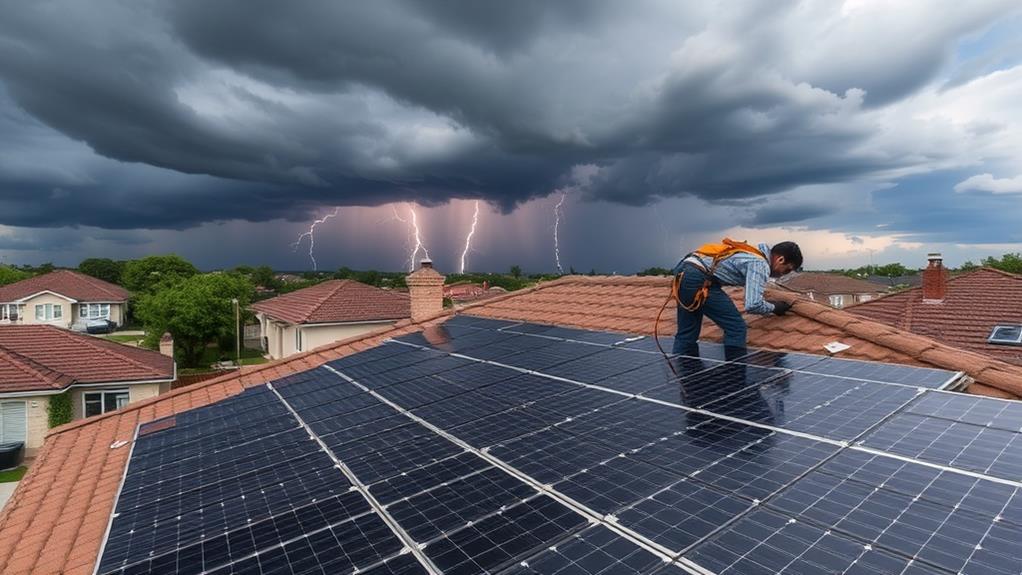
When storm clouds gather on the horizon, proactive measures can significantly enhance the resilience of your solar panel system. Begin by securing loose components and tightening all mounting hardware. Inspect the panel frame and racking system for any signs of weakness or corrosion, addressing issues promptly to prevent storm-related damage.
Clear debris from around the panels and ensure proper drainage to prevent water accumulation. Consider installing a rapid shutdown system that allows for quick power disconnection in case of emergency. Trim nearby trees or branches that could potentially fall onto the panels during high winds.
Review your insurance policy to confirm coverage for storm-related damage to solar installations. Document your system's condition with photographs before the storm hits. If severe weather is imminent, consult with your solar installer about temporary protective measures, such as removable storm shutters for ground-mounted systems.
Prepare a backup power source, like a generator, to maintain essential functions during outages. Finally, stay informed about local weather forecasts and follow evacuation orders if issued. By implementing these preparation measures, you can minimize the risk of storm damage and protect your solar energy investment.
Insurance Coverage Considerations
Protecting your solar panel system extends beyond physical preparations to include adequate insurance coverage. Homeowners should review their existing policies to ensure solar panels are explicitly covered. Many standard homeowners insurance policies include solar panels as part of the home's structure, but it's crucial to confirm this with your insurance provider.
Consider adding specific endorsements or riders to your policy for comprehensive protection. These additions may cover risks such as damage from extreme weather events, electrical failures, or even theft. Some insurers offer specialized solar panel insurance that addresses unique risks associated with these systems.
Be aware of coverage limits and deductibles, as high-value solar installations may exceed standard policy limits. Document your system's value, including installation costs and energy production estimates, to ensure proper coverage. Additionally, inquire about coverage for loss of income if your system is damaged and unable to produce electricity.
For leased systems or those covered by power purchase agreements, verify who is responsible for insurance—you or the leasing company. Regularly update your policy as you make changes or upgrades to your solar panel system to maintain appropriate coverage.
Post-Storm Assessment Protocol
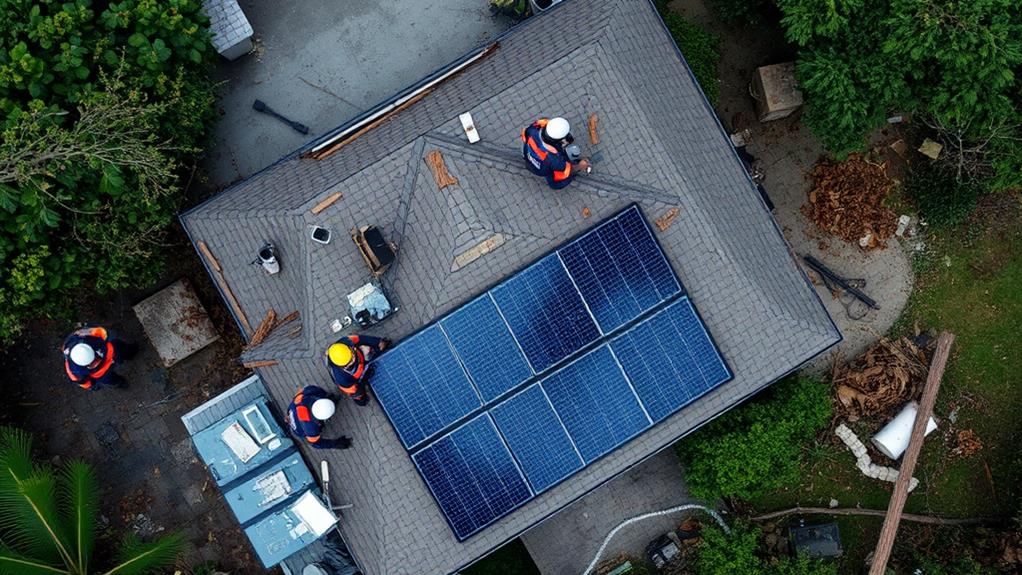
After every storm, a thorough assessment of your solar panel system is crucial to ensure its continued efficiency and safety. Implement a structured post-storm protocol to identify and address potential issues promptly.
Begin with a visual inspection from the ground, looking for obvious signs of damage such as loose panels, debris accumulation, or visible cracks.
If safe to do so, conduct a closer examination of the panels, mounting hardware, and wiring. Check for water infiltration, loose connections, or compromised seals. Document any findings with photographs for insurance purposes. Monitor your system's performance through its monitoring software or app, comparing post-storm output to typical levels.
Engage a certified solar technician for a professional inspection if you suspect significant damage or notice a marked decrease in energy production. They can perform detailed diagnostics and thermal imaging to detect hidden issues. Additionally, have your roof inspected by a qualified roofer to ensure the storm hasn't compromised its integrity, potentially affecting your solar installation. Promptly address any identified problems to maintain system efficiency and prevent further damage.
Frequently Asked Questions
Can Solar Panels Increase the Risk of Lightning Strikes on My Home?
Solar panels do not inherently increase the risk of lightning strikes on your home. However, proper installation and grounding are crucial to ensure safety. Professional installers follow strict electrical codes to mitigate any potential risks associated with lightning.
How Do Solar Panels Affect the Resale Value of My Property?
By jove, solar panels can indeed affect property resale value. Generally, they increase a home's value by enhancing energy efficiency and reducing utility costs. However, the impact varies based on location, market conditions, and system quality.
Are There Any Local Zoning Restrictions for Installing Solar Panels?
Local zoning restrictions for solar panel installation vary by municipality. Many areas have specific regulations regarding placement, height, and aesthetics. It's crucial to check with your local zoning office or planning department before proceeding with installation to ensure compliance.
Can I Install Solar Panels on a Flat or Unconventionally Shaped Roof?
���� Like a chameleon adapting to its environment, solar panels can be installed on various roof types. Flat and unconventionally shaped roofs often require specialized mounting systems and careful planning to ensure optimal energy production and water drainage.
What Happens to Excess Energy Produced by Solar Panels During Storms?
During storms, excess energy produced by solar panels is typically fed back into the power grid or stored in batteries if available. Grid-tied systems automatically shut off for safety, while off-grid systems may continue to charge batteries or divert excess power.
Conclusion
Protecting solar panels and roofs from storm damage requires a multifaceted approach involving proper installation, regular maintenance, and proactive measures. While some may argue that the cost of these precautions outweighs the benefits, the long-term savings and energy security provided by a well-protected solar system far exceed initial investments. By adhering to industry standards, utilizing advanced weather monitoring, and maintaining comprehensive insurance coverage, homeowners can safeguard their solar investments and ensure continued clean energy production, even in the face of severe weather events.
